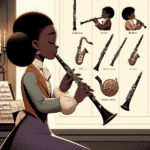The clarinet, a beloved woodwind instrument known for its rich tone and expressive capabilities, has a history spanning several centuries. Learning about its evolution can deepen your appreciation for the instrument and enrich your playing experience. Let's explore the fascinating history of clarinet music, examining key facts, influential musicians, and the clarinet's impact on various genres.
The Origins of the Clarinet
The clarinet's story began in the early 18th century. It evolved from earlier instruments like the chalumeau, which had a limited range and was mainly used in folk music. In 1700, Johann Christoph Denner, a German instrument maker, developed the clarinet by adding an extended tube and a register key, giving it greater range and versatility. This resulted in a single-reed instrument with a powerful voice, suitable for both orchestral settings and solo performances.
Timeline: Evolution of the Clarinet
- 1700: Johann Christoph Denner develops the clarinet
- 1750-1820: Classical era – Clarinet gains popularity in orchestras
- 1820-1910: Romantic period – Clarinet becomes more expressive
- 1910-1950: Jazz era – Clarinet takes center stage in swing music
- 1950-Present: Modern era – Clarinet continues to evolve in various genres
The Clarinet in the Classical Era
During the Classical era, the clarinet quickly rose to prominence. Composers like Mozart, Beethoven, and Weber began writing concertos and chamber works featuring the clarinet. Mozart's Clarinet Concerto in A major (K. 622), composed in 1791 for clarinetist Anton Stadler, remains one of the most beloved pieces in the clarinet repertoire today. This concerto showcased the instrument's lyrical qualities and established it as a key voice within the orchestra.
Key Highlights from the Classical Era
- Development of the Clarinet Family: The 18th and 19th centuries saw the creation of various clarinet models, including the basset horn and the bass clarinet. These new instruments allowed composers to explore fresh textures and timbres.
- Rise of Clarinet Virtuosos: Players like Alfred Arnold and Richard Mühlfeld brought the clarinet into the spotlight, demonstrating its technical prowess and expressive range through performances and compositions during this period.
The Romantic Period's Innovations
As music transitioned into the Romantic period, composers began to embrace the clarinet's emotional expressiveness. Works by Brahms, Debussy, and Mendelssohn expanded the repertoire beyond classical forms. Brahms, in particular, composed several pieces for clarinet, including his Sonatas for Clarinet and Piano, which are now staples in the clarinet repertoire. The use of the clarinet in orchestral and chamber music grew significantly, leading to the instrument's deep integration into the musical landscape of the era.
Clarinet in Jazz: A New Era
The clarinet experienced a rebirth in the jazz scene of the 20th century. Musicians such as Benny Goodman, Artie Shaw, and Sidney Bechet changed how people saw the clarinet, using it not just as a classical instrument but as a leading voice in jazz. Goodman's ensemble performances and iconic recordings helped make the clarinet popular in a whole new context, showing off its flexibility across improvisational styles.
Influential Jazz Clarinetists
- Benny Goodman: Known as the “King of Swing,” Goodman played a key role in bringing jazz to mainstream audiences. His famous piece, Sing, Sing, Sing, is still considered a defining moment in jazz history.
- Sidney Bechet: One of the first important soloists in jazz, Bechet was known for his powerful sound and expressive style, often playing both the soprano saxophone and clarinet with equal skill.
Famous Clarinet Pieces Through History
| Era | Composer | Piece |
|---|---|---|
| Classical | Mozart | Clarinet Concerto in A major |
| Romantic | Brahms | Clarinet Quintet in B minor |
| 20th Century | Copland | Clarinet Concerto |
| Jazz | Benny Goodman | Sing, Sing, Sing |
Modern Developments in Clarinet Music
From the late 20th century to the present, the clarinet continues to be a vibrant force in various musical genres, from avant-garde classical compositions to contemporary jazz and popular music. Modern clarinetists explore extended techniques such as multiphonics, slap tongue, and circular breathing, further expanding the instrument's expressive potential.
Notable modern clarinetists like Anthony McGill and Eddie Daniels have taken up the mantle, captivating audiences with their technique and emotional depth. As new generations of musicians carry on the legacy of clarinet music, companies like Martin Freres continue to focus on quality craftsmanship, creating instruments that meet the changing needs of today's players.
Looking Ahead: The Clarinet's Future
Examining the clarinet today shows not just its rich history but also how it can adapt to different musical styles. The clarinet's unique qualities allow it to bridge musical genres, encouraging collaborations between classical, jazz, and contemporary styles. As we look to the future, the clarinet will no doubt continue to play a key role in music, winning over both musicians and listeners alike.
Whether you're an experienced player or new to the clarinet, knowing its rich history can strengthen your connection to the instrument. Be sure to explore the excellent range of clarinets from Martin Freres to find the perfect match for your musical journey!







